Dr. Jordi Solé is a researcher in the fields of climate, environment, ecology, and energy. He has a PhD in applied physics from the Polytechnic University of Catalonia, and has participated in 21 scientific projects, heading of four of them. Dr. Solé has had 54 articles published and is a reviewer for seven international journals. He has participated in more than 50 national and international scientific congresses. He has been the co-advisor of two doctoral dissertations and is the co-advisor of three doctorates. He has been a member of dissertation and thesis committees for awarding advanced degrees, and has 14 years’ experience as a lecturer in master’s and undergraduate programs, coordinating several subjects at the Autonomous University of Barcelona, the Polytechnic University of Catalonia and the University of Barcelona. Dr. Solé has worked in radio, television, and print media, and writes a blog in Catalan on topics related to energy, the environment, and their implications for society.
FEATURES|THEMES|Environment and Wildlife
Global Systemic Crisis and Buddhism: Toward a Change of Paradigm
The scientific community has been issuing dire warnings about the global environmental emergency for some time now, predicting a crisis for which irrefutable evidence has been piling up for decades. The pandemic as a case of zoonosis, the collapse of ecosystems and the consequent risk of global food security, the exhaustion of material resources, and climate change place us in an unprecedented era in the history of humanity. The socio-economic paradigm that we have reached obligates us, individually and collectively, to choose between upholding our privileged position or making a change so that the planet can be inhabitable for future generations.
This change can be handled through the integrating vision of Buddhism, which entails working at three levels: group, individual, and inner. In this article, we will see how science and Buddhism go hand in hand in both group and individual actions. However, Buddhism also gives us extremely useful tools with regard to our inner worlds for navigating the crisis with a holistic and integrating vision.
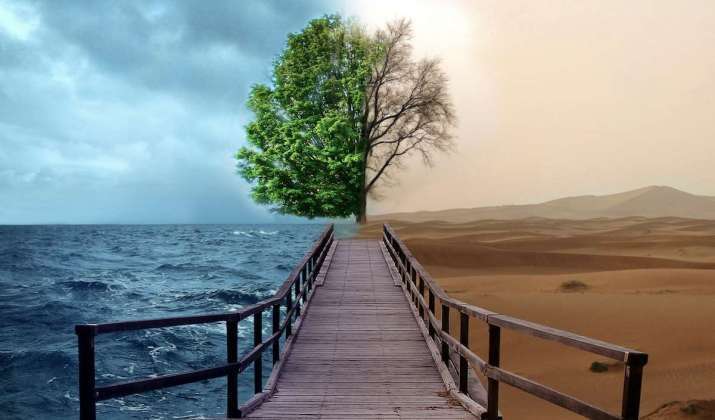 From see-change.org.au
From see-change.org.auThe three crises
For decades, science has been warning of the serious problems our civilisation will have to cope with if there is no change in direction that involves different ways of relating to nature and how we live in and with her. At present, scientific studies tell us that we have already passed several limits and that—if we continue in this way—in this decade we will head toward situations that will threaten not only our civilisation, but humanity and the entire biosphere, compared with how we live in and with them now. This situation can be seen as a global crisis in three areas: the climate, the biosphere and its ecology, and the resources needed to maintain our society—in particular the most important resource: energy. Here we will look briefly at each of these crises.
Climate
The climate crisis is here because the evolution of the physical and chemical variables that make up the atmosphere and oceans is changing in ways never before seen—even tracing geological records back at least a million years.* The concentration of greenhouse gases (GHG) such as CO2, the outcome of burning fossil fuels, have increased tremendously in recent decades. According to the Intergovernmental Panel on Climate Change (IPCC), the UN body that advises governments on climate change, this increase will have disastrous consequences for life on Earth. Such consequences include changes in rainfall patterns, increases in extreme events such as droughts and floods, rising sea levels, loss of Arctic ice, an increase in average temperatures, desertification, and more. For this reason, the IPCC is warning that GHG emissions must be reduced to zero in upcoming decades to ensure that the current situation, which is extremely fragile, does not deteriorate further.
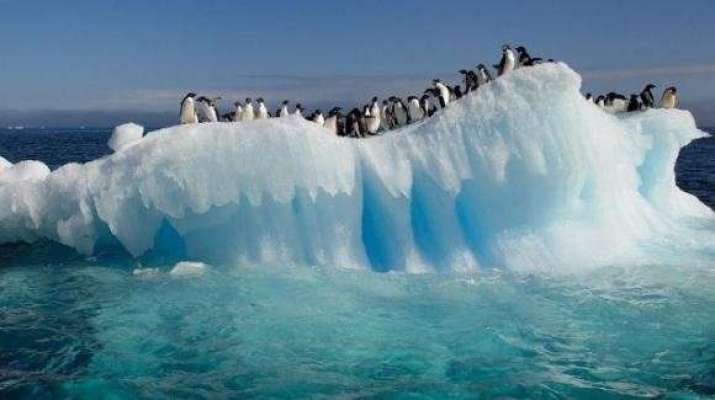 From news.fidelityhouse.eu
From news.fidelityhouse.euEcology
Another impact of our collective lifestyles is reflected in the ecological crisis. The changes that we are imposing on the planet’s ecosystems at all scales are significant: the loss of pollinator populations, loss of fertile soil, fewer aquifers, increases in invasive species, biochemical modification of our oceans, decreases in global food production with the consequent risk of food security, increases in pollutants of all types (e.g. plastics, heavy metals, and pesticides), and much more.
Energy
What ensures that our entire socio-economic system runs smoothly is access to huge volumes of energy that can be consumed quickly and easily. Historically, this has been possible due to the mass use of fossil fuels, the production and consumption of which has increased exponentially over time. However, this situation of increased production is threatened by two issues: stagnating production since 2010s with the peak in crude oil and the impossibility of continuing to exploit this energy source if we want to limit emissions. The problem we are facing now is the need to stop using fossil fuels and turn to other energy sources, primarily renewables.
There is a twofold problem with the transition to renewable energies. On the one hand, there are conditioning factors for using them: there is not always sun and wind when we need it, and supply issues (their energy density, or the amount of power that can be obtained from the occupied areais low, is low) that are very different from fossil fuels. On the other hand, the materials needed, such as copper, lithium, and neodymium, to be able to extract and store this energy are often in limited supply, as is the area that renewable facilities can occupy. Thus, the capacity to increase power production will be limited, with the resulting decrease in resources in a situation in which the two previously mentioned crises make our need for more energy essential.
These three crises place us in a situation of great uncertainty, since the changes that are taking place have impacts that are extremely difficult to predict. This uncertainty translates into greater fragility for our socio-economic systems and, hence, we as a society must plan how we can transform these systems by employing all the tools we have available. There is a strategic need to reflect on what the final social model could be that we wish to attain, bearing in mind that doing nothing will lead us into mass disaster and individual catastrophe.
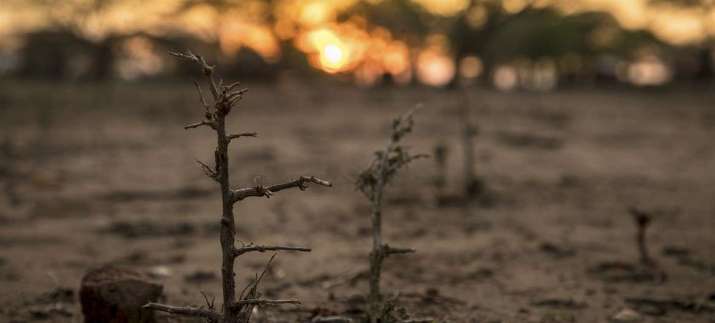 From ipsnoticias.net
From ipsnoticias.netScience and Buddhism for the future
Thus, we are at an unprecedented crossroads, not only for humanity but for the entire biosphere. In this regard, science occupies the rational sphere, with its empirical measures, aiming to take an independent stance from observers, meaning that it does not usually consider individuals and their behavioral changes as a key point in the required transformation. The future does, however, require transformations at all levels, combining external actions with changes in vision. And it is here that Buddhism contributes a complementary perspective to science to support managing the crisis and to assist with individual and social transformation, a transformation that starts with the individual and spreads throughout society.
Toward a paradigm change
As mentioned earlier, to prevent collective and individual calamity, we need a radical change in our understanding of the world, transforming ourselves from an individualist-utilitarian-material stance to a vision in which life itself is the central reference point. We start with a society with an individual-centric vision (Fig. 1) and from there society is built. Transforming this vision involves changes at three levels: group, individual, and inner/intimate. It is important to complement the vision of ecologism (protection of plant and animal species) with the Buddhist vision of protecting life based on love and compassion.**
Buddhist philosophy and practice emphasize both rational understanding through logical and empirical/scientific knowledge, and emotional management and practices. So, if we want long-lasting change, such changes cannot come exclusively from intellectual comprehension as we must experience what we have reflected in order to be able to integrate it into our lives.***
What is the existing paradigm and what could the future model be after this transformation? Today’s socio-economic paradigm is based on a distorted view of the world—as humans, we see ourselves as separate from nature and the ecosystem. This modern-day vision can be summarised in three core ideas:
1. Limitations/individualism as the basis for personal improvement;
2. Materialism/utilitarianism and, thus, the objectification of humans and non-humans;
3. Progress as the engine of social change.
Because they are antinatural, these mainstays produce a state that is far from peaceful, due to the basic dissatisfaction that seeks being rewarded and, from there, the creation of agitation and stress. Fig. 1 contains a diagram of how this paradigm organizes the notions of individual, society, ecosystem, and the environment. The individual is at the base, although he has no inner reference and is therefore trapped in a materialistic conception or vision that relies on the three previous layers.
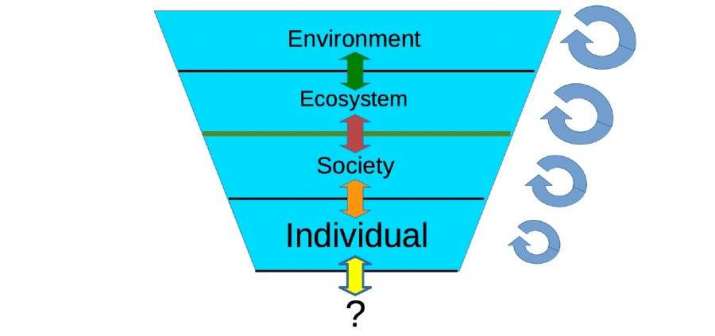 Fig. 1. The current vision of individual-society-environment interactions, in which individuals are located at the base, sustaining the rest and, in parallel, the importance of conceptualizing individuals as the mainstay of this construction is not recognized. Image courtesy of the author
Fig. 1. The current vision of individual-society-environment interactions, in which individuals are located at the base, sustaining the rest and, in parallel, the importance of conceptualizing individuals as the mainstay of this construction is not recognized. Image courtesy of the authorBearing in mind the above, a new paradigm must offset the distortion from three core areas:
1. Balancing out individualism with empathy;
2. Materialism and objectivization (reification) with a transcendent vision;
3. The idea of progress as well-being and an engine for social change for a greater presence and awareness that is expressed via greater vitalism and value of everything that we experience.
Moreover, and as mentioned, these external symptoms manifest through stress and agitation, thus requiring a regular meditation practice for greater mental hygiene to offset this stress with peace and serenity. This new paradigm is depicted in Fig. 2, with vision at the center and placing the outer limits of the diagram with the environment as a conditioning factor for actions at all levels.
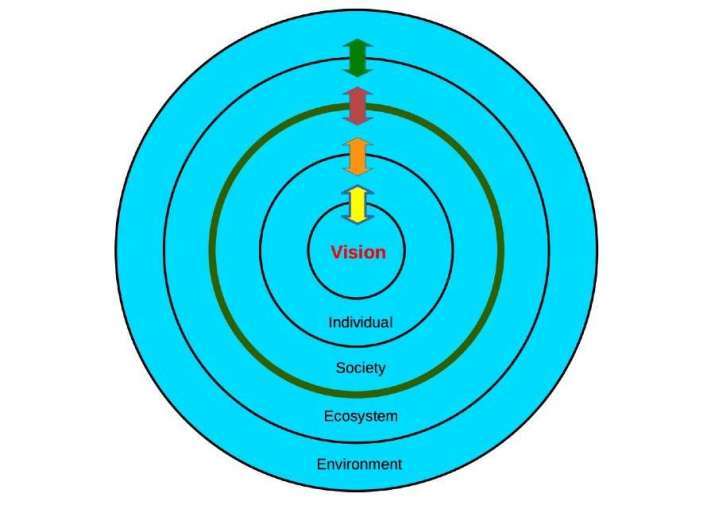 Fig. 2. The center of construction in the new paradigm is the individual’s vision of the world, from which the concept of the individual arises and how he relates to other human beings (society) and non-humans (ecosystem) and, as a whole, how they adapt to the environment.**** Image courtesy of the author
Fig. 2. The center of construction in the new paradigm is the individual’s vision of the world, from which the concept of the individual arises and how he relates to other human beings (society) and non-humans (ecosystem) and, as a whole, how they adapt to the environment.**** Image courtesy of the authorThis leads us to the fact that everything begins with internal personal change. In the personal sphere—beyond vision—altruism and generosity are the mobilizing forces. The empathic vision becomes the center of this transformation, which will progressively transform/feed back into experience and experiential knowledge. In the most practical arena, meditation is established as a tool for transformative work for peace of mind and serenity. Consequently, the aim is to end up reducing individualism and stimulating growth in cooperation. The final diagram after this transformation is shown in Fig. 3 where, by integrating transcendent and individual visions, there is an experiential vision of the interconnections and overlapping of the different spheres of interaction: visionary, individual, societal, and ecological.
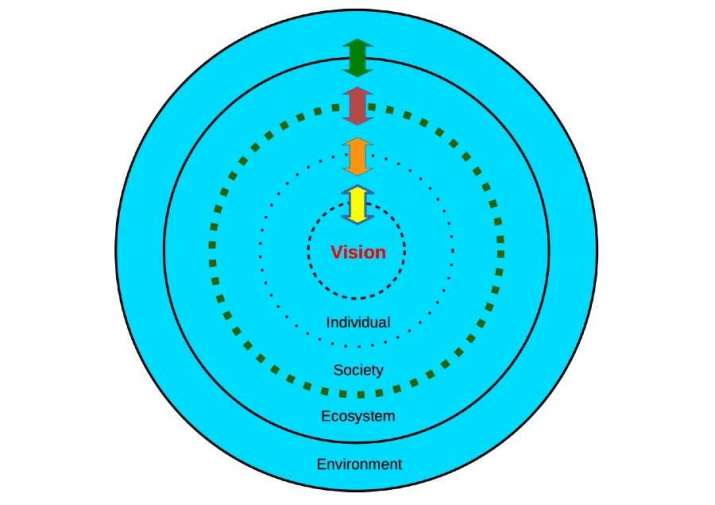 Fig. 3. The final objective is to break free from the limits that enclose each of the layers and to create a larger consciousness from the overlapping of vision-individual-society-ecosystem. Image courtesy of the author
Fig. 3. The final objective is to break free from the limits that enclose each of the layers and to create a larger consciousness from the overlapping of vision-individual-society-ecosystem. Image courtesy of the authorConclusion
We are facing three large crises. These crises require a shift in our social paradigm that must be based on a new vision of the world. The Buddhist philosophy complements science to assist with this essential change, as this change springs from internal transformation, working on inner peace, transcendence, presence and—above all—empathy. With this new outlook, we can help with this huge collective challenge. To learn more, one can see more at the conference “Global Systemic Crisis and Buddhism: Towards a Change of Paradigm.” ***
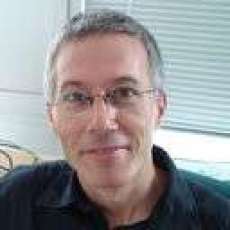
* Atmospheric CO₂ concentration (Our World in Data)
** Sakya Trichen. 2020. Freeing the Heart and Mind: Part Three: Teachings of the Sakya Path Boulder, CO: Shambhala Publications.
*** Crisis sistémica global y budismo: hacia un cambio de paradigma. Por Jordi Solé (YouTube)
**** Lama Rinchen Gyaltsen: Cómo superar el miedo (YouTube)
Related features from Buddhsitdoor Global
No Poverty: The Sustainable Development Goals and Buddhism
We Are the Flowers in the Garden
Earth in Crisis: What Is Our Calling?
Is This Buddhism? The Oneness of Spiritual Liberation and Social Justice
Buddhistdoor View: Finding the Right Balance with Social Justice Causes
Touching the Earth: An Ecodharma Retreat














